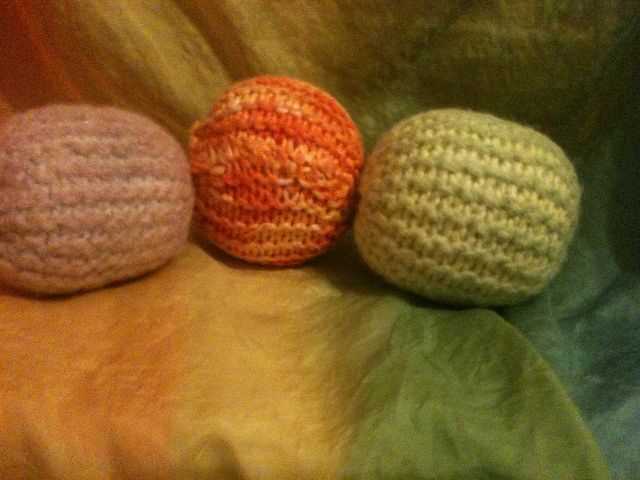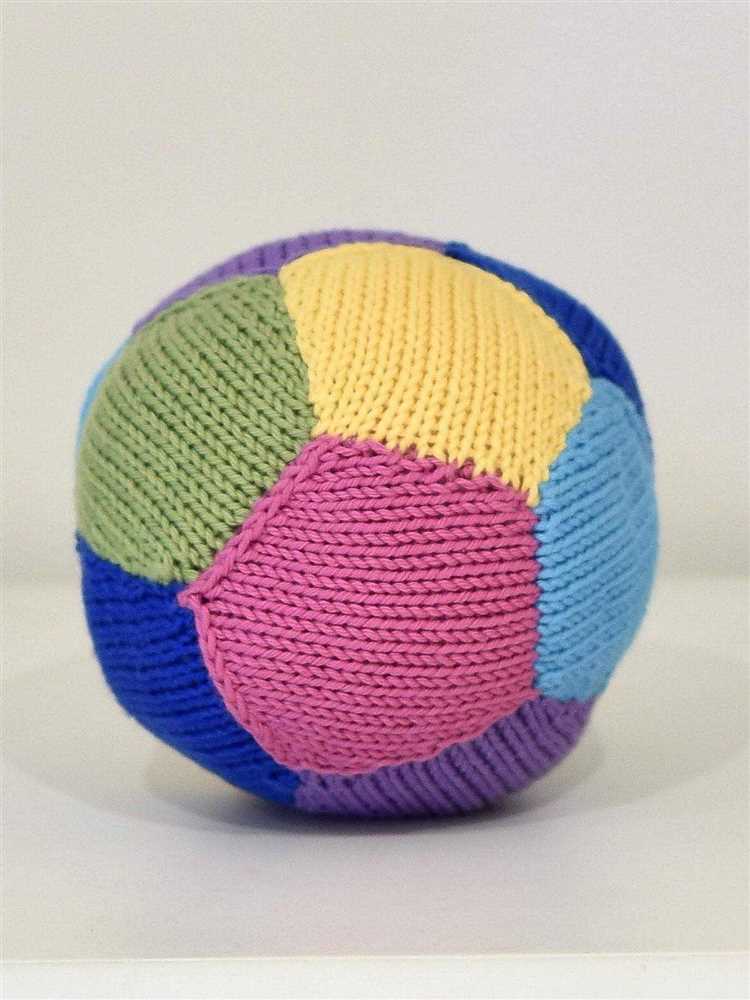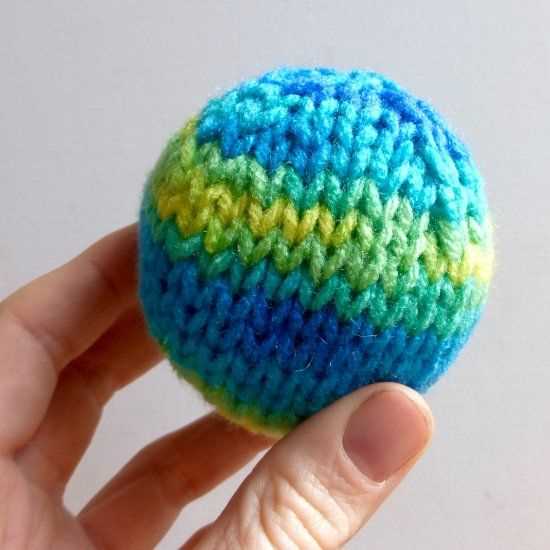Are you interested in learning how to knit a ball? Knitting is a timeless craft that allows you to create beautiful and cozy items. Knitting a ball is a great project for beginners as it introduces you to the basic techniques of knitting while also giving you a fun and practical item to enjoy.
In this step-by-step tutorial, we will guide you through the process of knitting a ball from start to finish. Whether you are new to knitting or just looking for a new project to try, this tutorial will help you create a perfect knitted ball.
To begin, you will need some basic knitting supplies. Gather your knitting needles, yarn, and a pair of scissors. It’s important to choose a yarn that is suitable for the project, such as a medium weight yarn that is easy to work with. You can also choose a variety of colors to make your ball more visually appealing.
Once you have your supplies ready, we will start by casting on stitches. This is the first step in any knitting project and sets the foundation for your ball. Follow our step-by-step instructions to cast on the desired number of stitches.
Next, we will move on to knitting the body of the ball. This involves knitting in rounds, using techniques such as knitting, purling, and increasing. We will guide you through each step, ensuring that you understand the techniques and can follow along easily.
Finally, we will finish off the ball by closing the stitches and securing the yarn. This will give your ball a neat and finished look. Once completed, you can stuff it with filling and sew it closed to create a soft and squishy knitted ball.
By the end of this tutorial, you will have a beautifully knitted ball that you can use for decorative purposes, as a toy for children, or even as a stress ball. So grab your supplies and let’s get started on this knitting adventure!
Getting Started with Knitting
Knitting is a popular craft that involves creating fabric by interlocking loops of yarn with knitting needles. Whether you’re a complete beginner or have some experience with knitting, here are some essential steps to get started:
- Choose Your Tools: To start knitting, you’ll need a pair of knitting needles and some yarn. There’s a wide variety of knitting needles available, but for beginners, it’s recommended to start with medium-sized straight needles made of bamboo or metal. As for yarn, choose a soft and smooth one that’s easy to work with.
- Learn the Basic Stitches: The two most common knitting stitches are the knit stitch and the purl stitch. The knit stitch creates a smooth, stockinette pattern, while the purl stitch creates a bumpy texture. Practice these stitches by casting on a few stitches and working rows of knit and purl stitches.
- Understand Knitting Patterns: Knitting patterns are a set of instructions that guide you through creating a specific item. They include information on the stitches, rows, and any special techniques required. Start with simple patterns that are labeled as beginner-friendly and gradually work your way up to more complex designs.
- Master Basic Techniques: In addition to knit and purl stitches, there are various other techniques you’ll come across in knitting. These include casting on (creating the first row of stitches), binding off (finishing the last row of stitches), increasing (adding stitches), and decreasing (removing stitches). Practice these techniques to expand your knitting skills.
- Join a Knitting Community: Knitting is a social activity, and joining a knitting community can be a great way to learn from others, get inspiration, and share your creations. Look for local knitting groups, online forums, or social media knitting communities to connect with fellow knitters.
Remember, knitting is a craft that takes practice and patience. Don’t get discouraged if your first few projects don’t turn out perfectly. With time and persistence, you’ll improve your skills and be able to create beautiful knitted items.
Choosing the Right Yarn and Needles
When it comes to knitting a ball, choosing the right yarn and needles is essential to achieve the desired results. Here are some factors to consider when selecting your materials:
Yarn Weight
The weight of the yarn determines the thickness and density of your knitting. For knitting a ball, it is best to use a medium or bulky weight yarn, such as worsted or chunky yarn. These yarns will provide enough structure and stability to create a round shape.
Fiber Content
The fiber content of the yarn affects its appearance, feel, and durability. You can choose different types of yarn, such as wool, acrylic, cotton, or a blend of fibers. Wool yarns are commonly used for knitting balls as they have good elasticity and help maintain the shape of the ball. Acrylic yarns are also a popular choice as they are easy to care for and come in a wide range of colors.
Needle Size
The size of the needles you use will determine the gauge, or tension, of your knitting. For knitting a ball, you will need needles of an appropriate size for your chosen yarn weight. Check the label on your yarn for recommended needle sizes. It is also helpful to have a set of double-pointed needles or a circular needle for knitting in the round.
Tension and Gauge
It is important to maintain an even tension while knitting to ensure consistent stitch size and gauge. Make sure to check your tension using a gauge swatch before starting your ball. This will help you determine if you need to adjust your needle size to achieve the desired gauge.
Color and Texture
Consider the color and texture of the yarn to achieve the desired look for your knitted ball. You can choose solid colors for a classic look or variegated yarns for a more playful effect. Additionally, yarns with different textures, such as boucle or mohair, can add interest and dimension to your ball.
By considering these factors, you can select the right yarn and needles for your knitting project and create a beautiful knitted ball.
Casting on Stitches
Casting on stitches is the first step in knitting a ball. It creates the foundation row of stitches that you will work with to create the ball shape. There are different methods for casting on stitches, and the one you choose will depend on your personal preference.
Here are some common methods for casting on stitches:
- Long-Tail Cast On: This is a versatile method that creates a neat and stretchy edge. It requires a long tail of yarn.
- Knitted Cast On: This method is simple and quick. It creates a firm edge and is great for beginners.
- Cable Cast On: This method is similar to the knitted cast on, but it creates a slightly stretchier edge.
- Backward Loop Cast On: This is the simplest method but can be a bit loose and difficult to work with. It is best for small numbers of stitches.
To cast on stitches, you will need your knitting needles and a ball of yarn. Follow the instructions for the chosen method to create the desired number of stitches on your needles.
Once you have cast on your stitches, you are ready to begin knitting the ball.
Knitting the First Rows
Now that you have cast on your stitches and completed the setup rows, you are ready to start knitting the first rows of your ball. Follow these steps:
- Hold the knitting needle with the stitches in your right hand and the empty needle in your left hand. Make sure the working yarn is coming from the last stitch on the right-hand needle.
- Insert the tip of the left-hand needle into the first stitch on the right-hand needle, from left to right.
- Take the working yarn in your right hand and wrap it around the right-hand needle, going counterclockwise.
- Use the right-hand needle to pull the loop of yarn through the first stitch, creating a new loop on the right-hand needle.
- Slide the old stitch off the left-hand needle, ensuring that the new loop stays in place on the right-hand needle.
- Repeat steps 2 to 5 for each stitch until you have completed the row. The newly knitted stitch will now be on the right-hand needle, and the old stitch will be on the left-hand needle.
Remember to keep your tension even and take your time as you work through the first row. It may feel a bit awkward at first, but with practice, it will become more natural.
Continue knitting additional rows following the same steps until you have reached the desired height for your ball.
Once you are comfortable with knitting the first rows, you can experiment with different stitch patterns or add stripes of different colors to make your knitted ball more unique.
Increasing Stitches to Shape the Ball
In order to shape the knitted ball, you will need to increase the number of stitches as you go along. Increasing stitches evenly throughout the work will create a round shape.
Here’s how you can increase stitches to shape the ball:
- Start by knitting a few rows of your ball in a flat shape.
- After completing a row, you will need to increase stitches. To increase, knit into the front and back of the same stitch.
- Repeat this increase in every other stitch across the row. This will double the number of stitches.
- Continue knitting several rows in the increased stitch count until the ball reaches the desired width.
- Once the desired width is achieved, you can start decreasing stitches to shape the top of the ball. This will be covered in the next section.
It’s important to keep track of the number of stitches and rows you have worked, especially when increasing stitches, to ensure an even shape.
Increasing stitches evenly throughout the work is a fundamental technique in shaping various knitting projects, including hats, sleeves, and more. Practice this technique, and you’ll be able to create a variety of shapes in your knitting projects.
Shaping the Ball with Decreasing Stitches
Once you have reached the desired diameter for your ball, it’s time to start the shaping process by decreasing stitches. Decreasing stitches will help create a more rounded shape for your ball.
Step 1: Identify the number of stitches you have on your needle. This will be your starting point for decreasing stitches.
Step 2: Divide the number of stitches by the desired number of decrease rounds. For example, if you have 60 stitches and want to shape the ball over 6 decrease rounds, you will decrease 10 stitches per round.
Step 3: Begin the first decrease round by knitting the first two stitches together, then continue knitting the rest of the stitches until you reach the last two stitches. Knit these last two stitches together. You have now decreased two stitches.
Step 4: Repeat the decrease round for the desired number of decrease rounds. Each round will have two fewer stitches than the previous round.
Step 5: Continue knitting the remaining stitches without decreasing until you have only a few stitches left on your needle.
Step 6: Break the yarn, leaving a long tail, and thread it through the remaining stitches on the needle. Remove the needle and pull the yarn tight to close the top of the ball.
Step 7: Weave in the ends of the yarn to secure them and trim off any excess.
And there you have it! You have successfully shaped your knitted ball using decreasing stitches. Now you can enjoy your new handmade toy or decorative item.
Finishing Off and Securing the Yarn
Once you have completed knitting your ball, it is important to properly finish off and secure the yarn to prevent unraveling. Follow these steps to properly finish off your knitted ball:
- Thread the yarn through a yarn needle: Cut the yarn, leaving a tail that is around 6 inches long. Thread the tail through the eye of a yarn needle.
- Weave in the loose ends: Use the yarn needle to weave the tail of the yarn in and out of the stitches on the wrong side of the fabric. This will help secure the yarn and prevent it from unraveling.
- Cut off any excess yarn: Once you have woven in the loose end, use a pair of scissors to carefully trim any excess yarn. Be careful not to accidentally cut any of the stitches.
By following these steps, you will ensure that your knitted ball stays intact and doesn’t come unraveled. This finishing technique is commonly used in knitting to secure the yarn and create a neat and professional-looking finish.
Adding Embellishments and Personal Touches
Once you have completed knitting the ball, you can add embellishments and personal touches to make it unique and special. Here are a few ideas to get you started:
- Embroidery: Use embroidery thread or yarn to add decorative stitches or patterns to the surface of the ball. You can create flowers, animals, or geometric designs to personalize your knit ball.
- Buttons: Sew on buttons in various colors and sizes to add a playful and textured look to your ball. You can create a polka dot effect or arrange them in a specific pattern.
- Ribbons and bows: Tie ribbons or bows around the ball for a feminine and elegant touch. You can choose satin, lace, or printed ribbons to match the color scheme of your ball.
- Charms: Attach small charms or pendants to the surface of the ball using a thread or yarn. This will add a whimsical and decorative element to your knitted creation.
- Pom-poms: Make small pom-poms using leftover yarn and attach them to the surface of the ball. This will add texture and playfulness to your creation.
Remember to secure any embellishments tightly to ensure they do not come off during use. You can use a thread or yarn to sew them onto the ball.
Adding these embellishments and personal touches will make your knitted ball stand out and reflect your own style and creativity. Have fun experimenting with different ideas and make each ball truly unique.
FAQ:
What materials do I need to knit a ball?
To knit a ball, you will need yarn, knitting needles, a tapestry needle, and stuffing.
What kind of yarn is best for knitting a ball?
A smooth and durable yarn, like cotton or acrylic, is best for knitting a ball.
Can I use circular knitting needles to knit a ball?
Yes, you can use circular knitting needles to knit a ball. However, you will need double-pointed needles or a set of circular needles with a small circumference for the decreases.
How do I stuff the ball after I finish knitting it?
After you finish knitting the ball, leave a long tail of yarn. Thread the tapestry needle with the tail and use it to stitch through the stitches at the top of the ball, pulling tight to close the opening. Then stuff the ball through the small opening at the bottom, using the tapestry needle or your fingers to evenly distribute the stuffing.
Do I need to know any special knitting techniques to knit a ball?
No, you do not need to know any special knitting techniques to knit a ball. This tutorial covers all the basic stitches and techniques you need to know.


